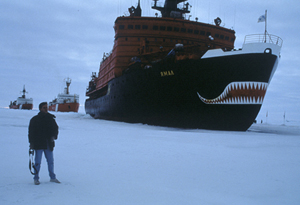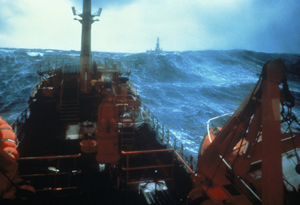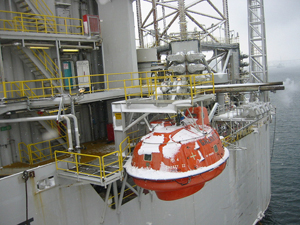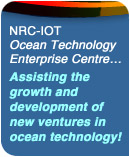
| IOT Patents | ||
| Databases | ||
| Publications | ||
| Printable version |

Research
The NRC Institute for Ocean Technology is Canada's national centre for ocean technology research and development. Its research program is aimed at improving technology performance and the safety of operations in the ocean. The program is organized into five principal areas:
Ships & Structures in Ice
 |
Goal: To predict from numerical and physical models the design and performance loads for structures and ships operating in ice.
Objectives for 2005-06:
- A functioning numerical model of bergy-bit impact events in full scale or model scale tests. A. Derradji, R. Gagnon, S. Jones
- Maneuvring equations for ships in ice. A. Derradji, M. Lau
- A pair of working podded propellers for model scale ice breaker tests. A. Akinturk, P. Liu
Other researchers: D. Molyneux
Performance Evaluation in the Ocean Environment
 |
Goal: Reliable performance prediction for ships, structures, and energy transfer systems in the marine environment, through numerical and physical modeling. Sustained revenue stream based upon world-class performance evaluation technologies.
Objectives for 2005-06:
- Computational fluid dynamics models of escort tugs operating at high yaw angles. D. Molyneux
- Model-ship correlation for fishing vessel motions in waves. D. Cumming
- Model scale experimental results for ocean energy extraction technologies. E. Baddour, F. Winsor
Underwater Vehicle Systems
 |
Goal: To establish the national facility for responsible exploration and utilization of the underwater world.
Objectives for 2005-06:
- Deliver and commission two underwater gliders. R. Bachmayer, C. Williams
- Commission an acoustic positioning system for the Offshore Engineering Basin. R. Bachmayer, C. Williams
- Complete a performance characterization of the Marine Dynamic Test Facility. R. Bachmayer, C. Williams
Applied Hydrodynamics
 |
Goal: Develop technology to provide accurate predictions of motion and loads on structures for deepwater resource exploration.
Objectives for 2005-06:
- Improve wave quality and wave characterization in the Offshore Engineering Basin. E. Baddour, H. Zaman
- Validate a wave-current interaction model. E. Baddour
- Develop modular apparatus for use in deepwater tests.W. Raman-Nair, F. Winsor
Marine Safety
 |
Goal: Predictable survivability through lifesaving systems during catastrophic events. Also predictable safe operations for small vessels.
Objectives for 2005-06:
- Model and full scale evaluation of 16, 42, and 100-person liferafts. A. Simoes Re
- Develop numerical models for chutes and slides. S. Chin, W. Raman-Nair
- Initiate a program to improve fishing vessel safety. A. Akinturk, D. Cumming
The Institute has a sixth research area known as Innovation. Time and resources are allowed to investigate new ideas, even when the results or practicality are unknown. Projects undertaken under the Innovation category are short-term, allowing the Institute to determine whether further research is justified.
The research program of IOT is supported by the Canada Institute for Scientific and Technical Information, through its St. John's Information Centre.
|
Date Modified: 2005-02-21
|
||
